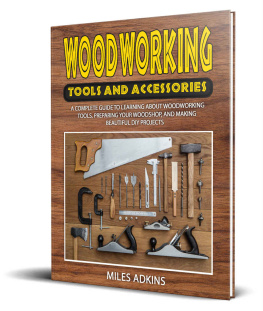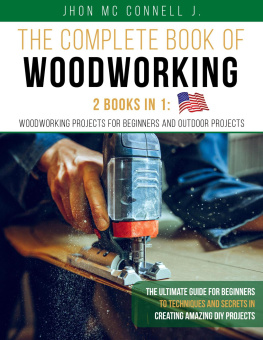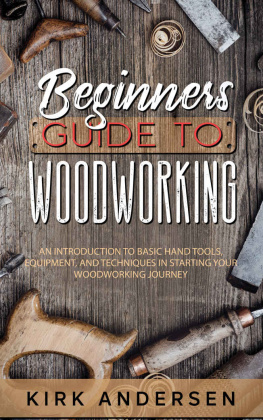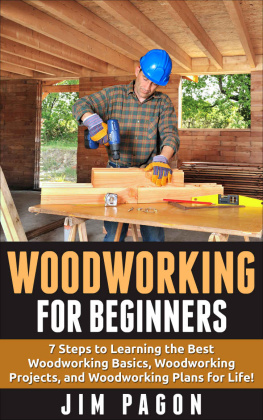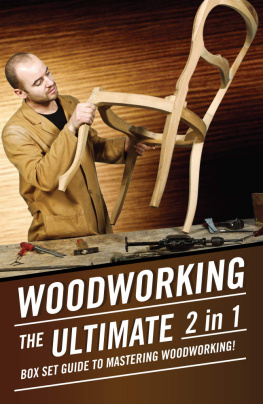Woodworking for Beginners
An Essential Guide to Learn the Art of Woodworking, its Processes and How to Produce Incredible DIY Projects
By
Miles Adkins
Copyright 2020 By (Miles Adkins) - All Rights Reserved.
This document is geared towards providing exact and reliable information in regards to the topic and issue covered. The publication is sold with the idea that the publisher is not required to render accounting, officially permitted, or otherwise, qualified services. If advice is necessary, legal or professional, a practiced individual in the profession should be ordered.
From a Declaration of Principles which was accepted and approved equally by a Committee of the American Bar Association and a Committee of Publishers and Associations.
In no way is it legal to reproduce, duplicate, or transmit any part of this document in either electronic means or in printed format. Recording of this publication is strictly prohibited and any storage of this document is not allowed unless with written permission from the publisher. All rights reserved.
The information provided herein is stated to be truthful and consistent, in that any liability, in terms of inattention or otherwise, by any usage or abuse of any policies, processes, or directions contained within is the solitary and utter responsibility of the recipient reader. Under no circumstances will any legal responsibility or blame be held against the publisher for any reparation, damages, or monetary loss due to the information herein, either directly or indirectly.
Respective authors own all copyrights not held by the publisher.
The information herein is offered for informational purposes solely, and is universal as so. The presentation of the information is without contract or any type of guarantee assurance.
The trademarks that are used are without any consent, and the publication of the trademark is without permission or backing by the trademark owner. All trademarks and brands within this book are for clarifying purposes only and are the owned by the owners themselves, not affiliated with this document.
Table of Contents
Introduction
There are just as many reasons for beginning woodworking as there are people curious about just getting started. Each craft has a set of critical design knowledge, resources, techniques, and materials at its core. For woodworking, this is the core knowledge, the fundamental know-how you need to be a skilled and effective artisan. The present-day woodworker carries on a noble tradition in a profession that is not only important today but will always be important, even if other fields contribute to some of its aspects and innovations. Without skill and a minimum of tools, the rookie woodworker can produce satisfying yet straightforward work in a short time. From this, he will go on to bigger things, because not only is woodworking an exciting hobby, but it can become a part or a full-time career. Power tools have their role in taking some of the monotony out of woodworking. Still, anybody who wishes to become professional in the art should learn hand methods before attempting extensive power tools. The worker can only understand the characteristics of wood in this way and learn how to make the most of the material. A significant part of woodworking craftsmanship is feeling the wood, which cannot be easily obtained when an electric motor is replaced with muscle strength. Even woodworkers who begin by doing a few simple things, like constructing shelves or boxes, ultimately would like to step on to more exciting projects. Woodwork construction has progressed through the years, creating joints, techniques, systems and methods which have been the time test. Wood has been the primary building material throughout the whole of history. Despite the many advancements in materials, especially in plastics, it is still likely to remain the preference for strictly practical items and for those where material beauty is essential. For such a wide range of building needs, no other material has the same appeal. It takes a long time for a tree to grow to the point that it can be felled and made into usable wood. A man planting trees is unlikely to see any return on his investment during his lifetime, other than the joy of watching them grow. Many trees have to produce several decades before they can be transformed into material that is of commercial value. Given this, trees continue to be felled rapidly, for both timber and paper-making items like pulp. While trees are felled at a much higher rate than replaced, there does seem to be plenty of wood to be found. Almost all wood that is of interest to the woodworker is exogenous or growing outward. Every year these trees increase in girth by increasing new timber rings around the outside of the old one. A small number of trees do not grow outward, including the palm, but they are of little value to woodworkers. Woodworking, with the aid of tools, can be described as the art of making things from different types of wood. Woodworking is used, as one of the world's oldest crafts, to produce both decorative and functional items. It has grown into a very successful hobby and a profitable occupation. Hardware, lumber, and hobby stores will buy the tools and materials needed for woodworking. Woodworkers shape the wood using both hand tools and power tools. Woodworking may include carpentry, painting, sculpture, spinning, furniture making and a lot more. As you can imagine, if you are interested enough to try it, this could quickly start as a hobby and turn into an exciting career. As a hobby, woodworking can be very rewarding and offer you many hours of leisure and the satisfaction of making various items from wood. While some people enjoy doing the actual woodworking, others prefer collecting and restoring beautiful works of art in wood. Woodworking is both soothing and exciting, particularly when you want to create stuff. All you need are tools, hardware and basic lessons that will help you get started to get started. You can create a range of decorative objects, objects you can use, and much more when you work with wood. There is a couple of methods to get started depending on what kind of woodworking you want to take on as a hobby, such as making furniture, carving, painting, sculpting, spinning, repairing things around your home or restoration work. One is going in for a fully fitted store. The first and most robust approach is to start small and accumulate the resources you need gradually. This is also a less costly way to get started because it can cost you thousands of dollars to build a workshop. There are also chances of you ending up using resources that you rarely use. Another thing is that one buys a product that has more than one use almost always. You can cut dados, for example, with a table saw or a router. A saber saw or a scroll saw may be used to complete curves. Therefore, as a beginner, consider investing in the appropriate sizes and shapes in a pre-cut kit with the wood pre-cut. Just match the parts and follow the instructions for building the piece. Most possibly, you'd need to nail, screw-on, paint, sand and finish the piece. Kits are generally composed of parts to make birdhouses, feeders, tables, plant holders and other simple things you can make and feel proud of. You can buy prepped up lumber in various widths if you move on to more complex woodworking ventures. If you are making a table, there are table legs and chair spindles and many other items that need to be turned and ready for use. First, go in for a basic pack. If you order your project as a package, you'll get directions and a list of the materials you need. You'll probably need hammers, measuring sticks, clamps, saws, cube, hand drills, and chisels, depending on what you want to make. That should cost you approximately $200 to $300.




